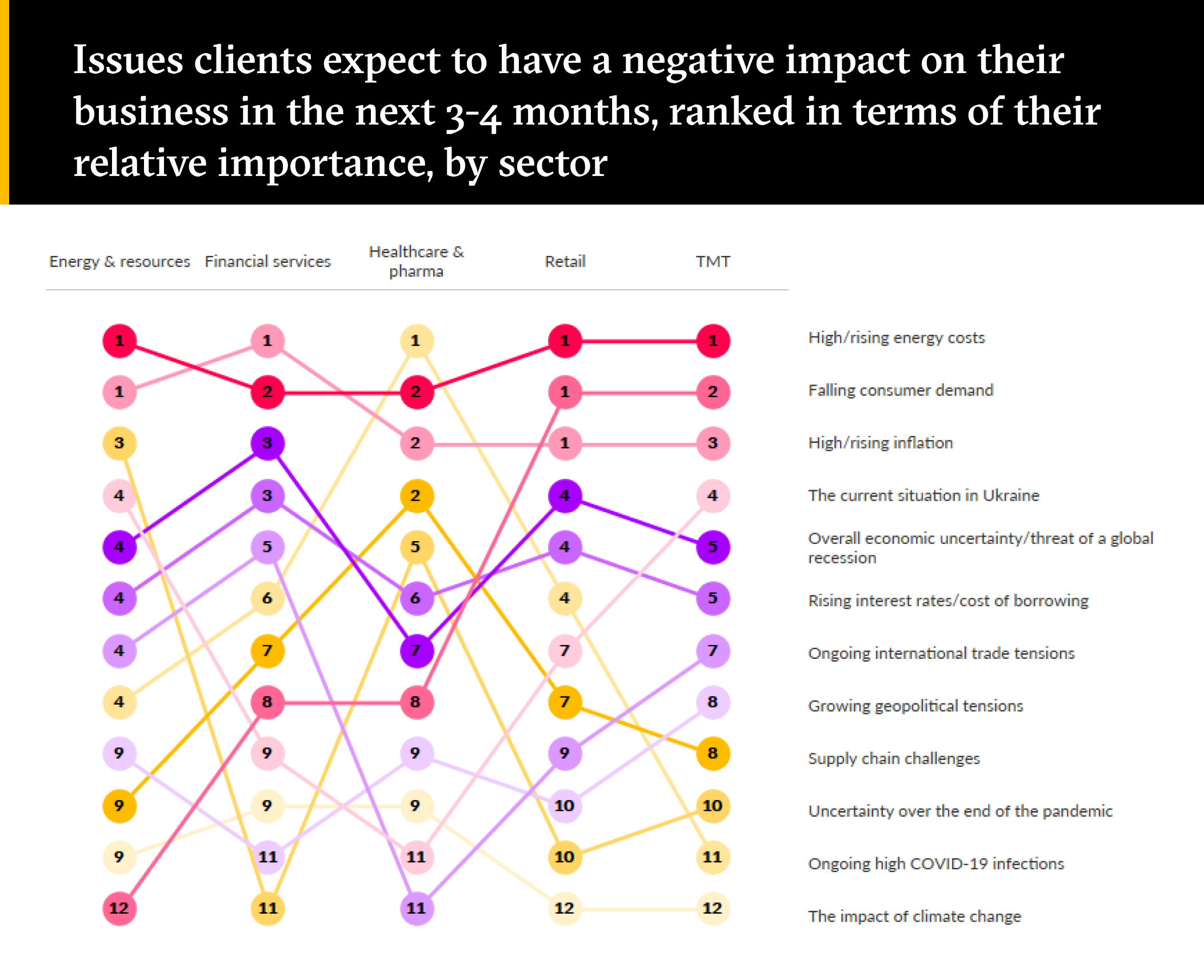The impact of macro-economic uncertainty by sector
Retail and TMT are likely to be the bellwethers of how the consulting market will perform in the coming months.
Previous analysis has suggested that, of the many macro-economic threats facing organisations, rising inflation and energy costs are the ones most likely to have a negative impact on them between now and the end of the year. However, from the professional services perspective, we have highlighted the importance of falling consumer demand. While consumer demand is not at the top of most clients’ worry lists at the moment, it’s the factor most likely to have a negative impact on their spend on consulting and other services. And while other factors—including rising inflation and energy costs—may reduce expenditure in some areas of consulting, this is likely to be offset by increased expenditure in others.
But how does this picture broadly appear to be playing out across different sectors? More specifically, where is falling consumer demand more of a concern?
As the chart below illustrates, high and rising energy costs are a serious concern across the board. However, these are seen to be more important issues (ranked number one) in the energy & resources, and the technology, media & telecoms (TMT) sectors, both of which depend on massive energy consumption and large-scale physical investment programmes. These sectors are also especially likely to see war in Ukraine, with its consequent disruption of some types of resources, as a threat to their businesses. This concern is likely to drive up demand for help from professional services firms around forecasting and for scenario or contingency planning.
 High inflation is the biggest concern in the financial services sector. This is perhaps less in relation to the pricing of services and elasticity of demand (even in a crisis people need insurance and banking), and more in terms of rising wage bills in a sector that remains very headcount-intensive, despite decades of investment in technology. Rising interest rates have, of course, a different impact on those who lend money than on those that borrow it, but the prospect of rising bad debts and defaults is closely tied to worries about an imminent global recession. While clients’ spend on support with economic analysis and scenario planning will be relevant in this sector too, it may be as motivated by a shortage of internal capacity as by a lack of capability: On-going COVID infection rates are a significant issue here, again driven by the number of people employed in this sector and the prospect that the winter months will bring a return to the operational difficulties of the last two years. Consulting firms may find their services are in demand to help fill business-as-usual positions.
High inflation is the biggest concern in the financial services sector. This is perhaps less in relation to the pricing of services and elasticity of demand (even in a crisis people need insurance and banking), and more in terms of rising wage bills in a sector that remains very headcount-intensive, despite decades of investment in technology. Rising interest rates have, of course, a different impact on those who lend money than on those that borrow it, but the prospect of rising bad debts and defaults is closely tied to worries about an imminent global recession. While clients’ spend on support with economic analysis and scenario planning will be relevant in this sector too, it may be as motivated by a shortage of internal capacity as by a lack of capability: On-going COVID infection rates are a significant issue here, again driven by the number of people employed in this sector and the prospect that the winter months will bring a return to the operational difficulties of the last two years. Consulting firms may find their services are in demand to help fill business-as-usual positions.
On-going high infection rates is the number-one concern in the healthcare and pharma sectors and sits alongside worries about inflation and energy costs, but also supply chain challenges (which will, no doubt, raise inflation further). In such a specialised sector, where so much activity is focused on frontline support, logistics, and manufacturing, the scope for professional services to support short-staffed functions is limited. Instead, it’s likely that healthcare and pharma organisations will turn to external suppliers for help improving productivity and technology—although with straitened resourcing, such work will be tactical and focused on yielding instant results.
All of which brings us back to falling consumer demand. At present, this is ranked as of relatively low concern in the energy & resources, financial services, and healthcare & pharma sectors, either because consumer demand won’t fall (in financial services and healthcare) or because investment plans are necessarily very long-term and so unlikely to be swayed by—what will hopefully turn out to be—short-term changes in buying behaviour (in energy & resources, and in healthcare & pharma).
Unsurprisingly, the picture is very different in the retail and TMT sectors, which are exposed to changing consumer demand both more immediately and to a greater extent. While staple goods (food) and utility-type services (broadband) aren’t likely to suffer significant reductions, in these huge sectors, even small percentage changes can have an impact. Moreover, demand for higher-end goods and services could fall significantly, as rising inflation outstrips salaries and leaves people with less disposable income.
It therefore seems likely that these two sectors—retail and TMT—will be the ones where we’re most likely to see a slowdown in spending on consulting and other professional services. Firms will adapt, but they will need very compelling and cost-effective solutions that can have a rapid impact if they’re going to succeed in this space.